剑桥国际英语教程unit 7
- 格式:ppt
- 大小:99.00 KB
- 文档页数:18

Unit 7 At the farmP40-1 CD2-11Suzy:Look at those animals.this is a nice zoo.Mr:it isn’t a zoo.it’s a farm.Look,there is a cow under the tree.Simon:Oooo,Mum,the goat’s eating the new bag.Mrs:A,shooo.stop that .Stella:Look,Suzy,the baby sheep is drinking milk.Suzy:OoooooMr:Let’s give the duck some bread.Suzy: En, there is a frog.Simon:Look ,stella ,there is a lizard on your T-shirt.Stella:Ha-Ha Simon, very funny.I know.and I love lizard . Do you like spider ,Simon? Simon:No,I don’t .Stella:Well, there is a big black and ugly spider on your head.Simon:AAAAAP40-2 CD2-12cow duck goat lizard sheep spider frogP41-3 CD2-13 歌谣,书本上有字母不用打。
CD2-14伴奏P42-5 CD2-15Marie:Trevor,Can I have the sheep, please!Let’s put it here next to the cows. Trevor:Here you are !Monty:Wa I love sheep. Ba ba baTrevor:So do I .Maskman:I don’t .I love horses.Marie:Oh ,So do I.Trevor:I don’t .Horses are very big and they can kick.Maskman:What know?Monty:Let’s put the goat under the tree.Marie:No,Monty, it can eat the flowers. I love flowers.Maskman: So do I .Trevor:Flowers,Maskman?Do you love flowers ?Maskman:Yes,I do.I can give it to Marie.P42-6 CD2-16I love sheep .So do I.I love horses. I don’tP43 7.8 CD2-17.18I love Bla bla ,So do I P44---9,10 CD2-19.20 P45--11 CD2-21小故事书上有,不用打。
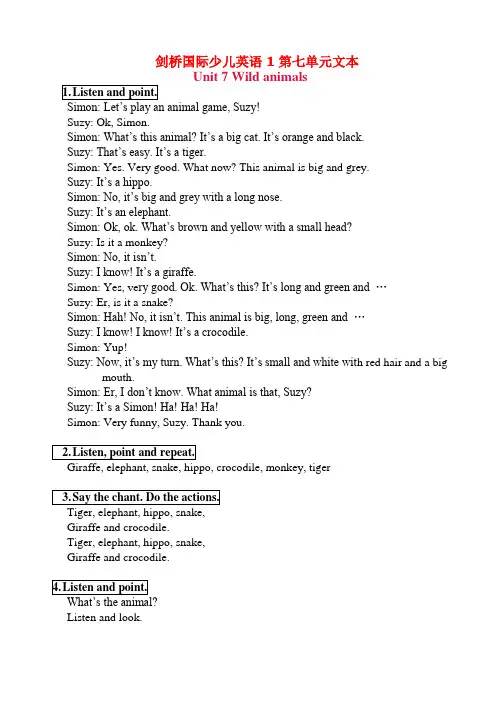
剑桥国际少儿英语1第七单元文本Unit 7 Wild animalsSuzy: Ok, Simon.Simon: What’s this animal? It’s a big cat. It’s orange and black.Suzy: That’s easy. It’s a tiger.Simon: Yes. Very good. What now? This animal is big and grey.Suzy: It’s a hippo.Simon: No, it’s big and grey with a long nose.Suzy: It’s an elephant.Simon: Ok, ok. What’s brown and yellow with a small head?Suzy: Is it a monkey?Simon: No, it isn’t.Suzy: I know! It’s a giraffe.Simon: Yes, ve ry good. Ok. What’s this? It’s long and green and …Suzy: Er, is it a snake?Simon: Hah! No, it isn’t. This animal is big, long, green and …Suzy: I know! I know! It’s a crocodile.Simon: Yup!Suzy: Now, it’s my turn. What’s this? It’s small and white wit h red hair and a big mouth.Simon: Er, I don’t know. What animal is that, Suzy?Suzy: It’s a Simon! Ha! Ha! Ha!Simon: Very funny, Suzy. Thank you.Giraffe and crocodile.Tiger, elephant, hippo, snake,Giraffe and crocodile.Listen and look.Point to the animal in this book.It’s small and brown.It’s long and gre en.It’s grey and dirty.It’s big and clean.It’s orange and black.It’s red and blue.It’s yellow and brown with a small head too.Come alive.Walk and talk.On the count of five.One, two, three, four, five.Maskman: What have you got there, Trevor?Trevor: I’ve got a book on animals. Look at these monkeys. They are funny. Maskman: Yes, they’ve got long arms and big hands. Oooh. What are they? Trevor: They are crocodiles. They are long and green and they’ve got b ig mouths and long tails.Monty: How many teeth have they got?Trevor: They’ve got a lot of teeth.Maskman: Have they got long legs?Trevor: No, they haven’t. They’ve got short legs and feet.Look at the snakes. They’ve got no legs and no feet.Maskman: Look at the elephants. They are big and grey.They’ve got very big ears, long noses and short tails.Monty: Hmmm. Elephants. They’re my favorite animals.They’ve got short legs.They’ve got long legs.They haven’t got feet.Animals, animals, short and tall.Animals, animals, dirty and clean.Animals, animals, brown and green.Come on children, sing along.Sing and move to the animal song.Le t’s all do the hippo show.Let’s all do the hippo showLet’s all do the hippo showMove your hands and feet.Let’s all do the elephant dance.Let’s all do the elephant dance.Move your arms and legs.Let’s all do the snake shake.Move your head and tail.L et’s all do the crocodile smile.Let’s all do the crocodile smile.Let’s all do the crocodile smile.Show your big white teeth.Let’s all do the giraffe laugh.Let’s all do the giraffe laugh.Let’s all do the giraffe laugh.Open your big clean mouth.Car, computer, crocodile, catCar, computer, crocodile, catCome alive.Walk and talk.On the count of five.One, two, three, four, five.Monty: Animals, animals, big and small. Animals, animals, short and tall. Marie: Help! Help, Maskman! Look at these snakes. They’re long and ugly and they’ve got two long teeth.Maskman: I’m here, Maree. I’ve got the snakes. Snakes have got two long teeth, but I’ve got two big arms.Marie: Ooohh, Maskman, thank you. You are a superhero.Trevor: Help! Help! Help, Maskman! Look at these crocodiles. They’ve got big mouths and they’ve got a lot of teeth.Maskman: I’ m here, Trevor. I’ve got the crocodiles. Crocodiles have got big mo uths and a lot of teeth, but I’ve got long legs and big hands. Trevor: Ooohh, Maskman, thank you. You are a superhero.Maskman: Help! Help! Look at these elephants. They are very big. And they’ve got very big feet. Aaaagghh!Monty: I’m here, Maskman! Elephants are very big and they’ve got very big feet, but I’m a mouse, I’m very small.Maskman, Trevor, Marie: Thank you,Monty. You are a small mouse, but you are a superhero.。
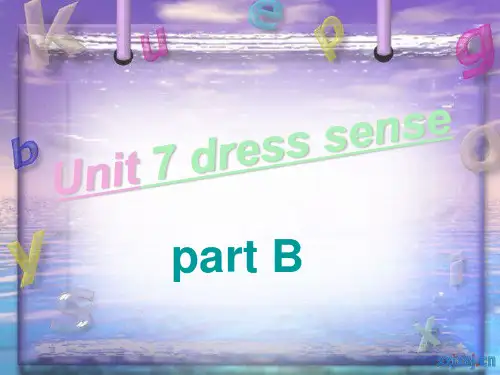
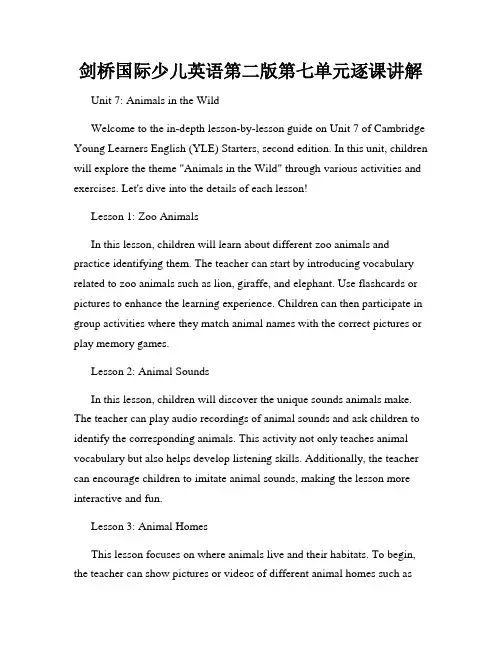
剑桥国际少儿英语第二版第七单元逐课讲解Unit 7: Animals in the WildWelcome to the in-depth lesson-by-lesson guide on Unit 7 of Cambridge Young Learners English (YLE) Starters, second edition. In this unit, children will explore the theme "Animals in the Wild" through various activities and exercises. Let's dive into the details of each lesson!Lesson 1: Zoo AnimalsIn this lesson, children will learn about different zoo animals and practice identifying them. The teacher can start by introducing vocabulary related to zoo animals such as lion, giraffe, and elephant. Use flashcards or pictures to enhance the learning experience. Children can then participate in group activities where they match animal names with the correct pictures or play memory games.Lesson 2: Animal SoundsIn this lesson, children will discover the unique sounds animals make. The teacher can play audio recordings of animal sounds and ask children to identify the corresponding animals. This activity not only teaches animal vocabulary but also helps develop listening skills. Additionally, the teacher can encourage children to imitate animal sounds, making the lesson more interactive and fun.Lesson 3: Animal HomesThis lesson focuses on where animals live and their habitats. To begin, the teacher can show pictures or videos of different animal homes such asnests, burrows, and caves. Children can work in pairs or small groups to match animals with their appropriate habitats. This activity promotes critical thinking and encourages children to learn about animals in their natural environments.Lesson 4: Animal Body PartsIn this lesson, children will learn about the different body parts of animals. The teacher can use visual aids to introduce vocabulary related to animal body parts, such as wings, fins, and tails. Children can then participate in interactive activities, like labeling animal diagrams or playing "Simon Says" to mimic animal movements. These activities not only teach vocabulary but also promote physical coordination.Lesson 5: Animal ActionsThis lesson focuses on the actions animals perform. The teacher can use pictures or videos to showcase animal behaviors like running, swimming, or flying. Children can imitate these actions individually or in pairs, promoting physical movement and enhancing vocabulary retention. Additionally, the teacher can organize a game of charades where children act out animal actions for others to guess.By following this lesson-by-lesson guide, teachers can effectively deliver Unit 7 of the Cambridge YLE Starters, second edition, ensuring an engaging and comprehensive learning experience for young learners. Remember to tailor the activities to suit the specific needs and language level of your students. Enjoy teaching "Animals in the Wild" and watch your students' English skills flourish!。
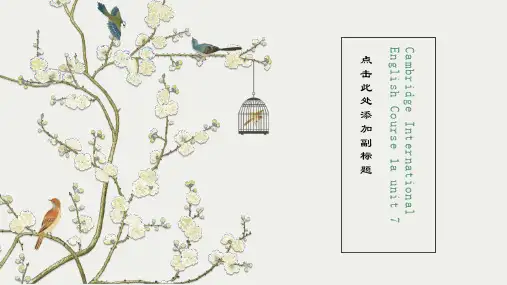
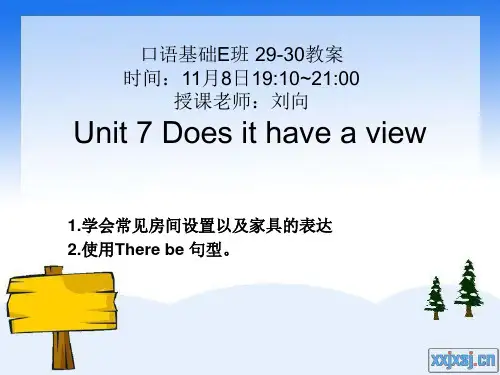

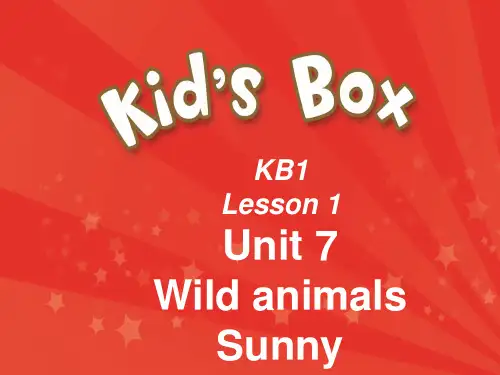
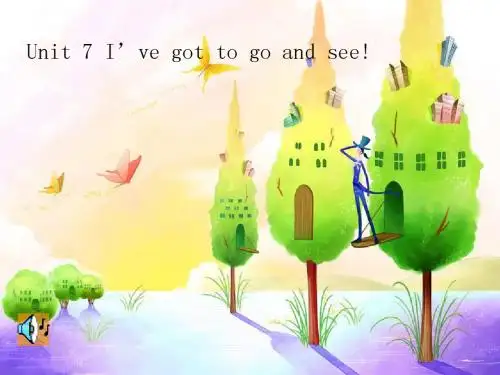
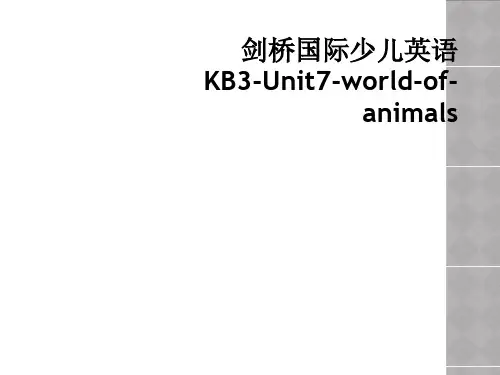
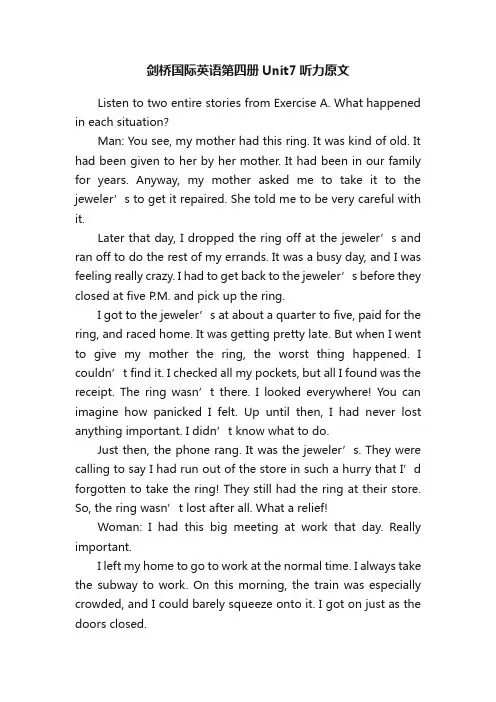
剑桥国际英语第四册Unit7听力原文Listen to two entire stories from Exercise A. What happened in each situation?Man: You see, my mother had this ring. It was kind of old. It had been given to her by her mother. It had been in our family for years. Anyway, my mother asked me to take it to the jeweler’s to get it repaired. She told me to be very careful with it.Later that day, I dropped the ring off at the jeweler’s and ran off to do the rest of my errands. It was a busy day, and I was feeling really crazy. I had to get back to the jeweler’s before they closed at five P.M. and pick up the ring.I got to the jeweler’s at about a quarter to five, paid for the ring, and raced home. It was getting pretty late. But when I went to give my mother the ring, the worst thing happened. I couldn’t find it. I checked all my pockets, but all I found was the receipt. The ring wasn’t there. I looked everywhere! You can imagine how panicked I felt. Up until then, I had never lost anything important. I didn’t know what to do.Just then, the phone rang. It was the jeweler’s. They were calling to say I had run out of the store in such a hurry that I’d forgotten to take the ring! They still had the ring at their store. So, th e ring wasn’t lost after all. What a relief!Woman: I had this big meeting at work that day. Really important.I left my home to go to work at the normal time. I always take the subway to work. On this morning, the train was especially crowded, and I could barely squeeze onto it. I got on just as the doors closed.Well, after a couple of minutes, I realized that my skirt had been caught in the subway doors. I could n’t pull it out! A man standing next to me tried to help me, but we still couldn’t get it. By this time, I was so embarrassed. Other people were staring at me. And my skirt was really stuck.Well, wouldn’t you know it, the doors to the subway opened on the other side for the next six or seven stations. I had to miss my stop. I just stood there, with my skirt stuck in the door, unable to move. Finally, the doors opened on my side. I was able to leave the train. Now I was really late.As soon as I arrived at work, my boss asked to speak to me.I know he would never believe why I was late. I felt so stupid! Of course, later we all laughed about it.Listen to actress Stella Hamptons talking about her life. What are some of her most embarrassing moments? Host: Hello, everyone, we’re talking to Stella Hamptons, famous Hollywood actress. Before the break, we were talking about your life, Stella, before you became a big star.Stella: Yes, … oh, but do we have to?Host: Well, I think it’s interesting. And I think our listeners will find it interesting, too. I mean, you didn’t become a big star overnight. You struggled for many years.Stella: You can say that again.Host: Tell us a little about it.Stella: Oh ,yes. I think I must have worked twenty or thirty different jobs.Host: Really?Stella: Sure! I couldn’t find work as an actress for many years, so I had to do something. You have to eat, right? Host: What kinds of jobs did you have?Stella: A little bit of everything; I worked as a waitress, in a department store, painting houses… I think I got fired from most of those jobs.Host: Oh, yeah? C’mon, tell us a few stories.Stella: This is so embarrassing… well, I remember I worked for a big department store in the hats department. It was so boring. We never had any customers during the day, and that’s when I worked. When I got sleepy, I used to lie down under the hat racks and take an occasional nap.Host: What happened?Stella: Well, one day I got caught- by my boss. And I got fired on the spot. Then there was the time I decided to paint houses. It turned out that I was allergic to the paint. And my body was so sore after working the first day, I could hardly get out of bed the next day. I couldn’t take the physical work. I got fired again.Host: Any other war stories?Stella: Well,…you’re not going to believe this, but I actually drove a taxi for a few days. I got hired as a cab driver. Host: No! You?Stella: Yes. I was desperate and thought I could make good tips. I needed the money at the time. Unfortunately, it didn’t last.Host: Fired?Stella: Yep. How did you guess? On my third day, I hit a pole. No one was hurt in the accident – my passenger was find – but it scared me to death. That was the end of my career as a driver.Host: Well, Stella, thanks for sharing those details with us. It’s a good thing you made it as an actress! After the commercial break, we’ll talk more with Stella about her new movie that’s being released in September.Listen to an early morning news broadcast. Write down the number of each type of news story you hear. Then take notes about what happened.Announcer: it’s seven o’clock and t ime for the news. Our top stories today:First, this from the World Health Organization, or the W-H-O. The W-H-O has reported that we are facing a potential global epidemic due to untreatable cases of tuberculosis, also known as TB. TB is dangerous because it affects the lungs. The number of cases is growing worldwide, and this has researchers worried. According to a study, a third of all known TB cases are untreatable. The drugs normally used to treat TB are simply not working. Researchers are trying hard to find out why this is the case. For now, the WHO is planning an international program to educate people about the dangers of TB.And now we have a report on the artist Vincent van Gogh. Of course, you may know that van Gogh is a famous nineteenth-century painter. You may also be familiar with one of his famous paintings: the one of flowers –sunflowers to be exact. It was painted in 1888 by van Gogh. Well, a scandal erupted in London yesterday over the authenticity of van Gogh’s Sunflowers. The painting was recently bought by a large multinational company for several million dollars. And now, an art expert is saying that the painting is a fake. Authorities are looking into the matter.Next, to Mexico. Hurricane Pauline pounded Acapulco and nearby areas last night, leaving many people homeless. The strong winds and heavy rains made for horrible conditions. Floods and landslides destroyed homes and cars, especially in the hillside areas. Rescue is particularly difficult because streets are blocked, in most cas es, by mud. It’s believed that some peoplemay be trapped inside their homes and cannot get out. Most people have left their homes and are now safely in temporary shelters. This natural disaster is going to have a big impact on the tourist business in Acapulco this year.Finally, a story for all you parents out there: How often do your kids push you to your limit, and what do you do about it? One tired and harassed mother form Illinois decided she’d had enough yesterday. Instead of yelling at her children, as she normally would, she decided to leave. She walked out the door and climbed a tree –the tree with her children’s tree house in it, that is. She decided to stay in the tree house until her three children stopped misbehaving. She told her children she had decided to stay in their tree house until they started appreciating her more. She put a sign in front of the tree house that said”on strike –No cooking, cleaning, doctoring, banking, or driving until demands met.”The children tried to persuade her to c ome down, but no luck. Finally, one of them had the smart idea of baking their mother’s favorite treat – brownies. Well, they must have smelled good because that did the trick. Mom agreed to come down and meet her children at the bargaining table. No word yet on the outcome of those negotiations, though. That’s it for now. We’ll be back in an hour with more news.。